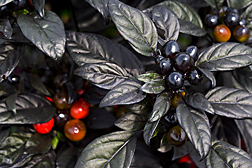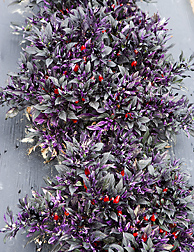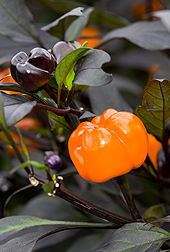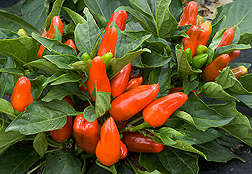Twice as Nice Breeding Versatile
Vegetables

An experimental
line of beautiful, tasty peppers. The
purplish-blue fruit are immature; the
red, mature.
(D254-24) |
Can you eat your peppers and have them too?
Yes, you can. At least, that’s the opinion of
two
Agricultural Research Service geneticists.
Since 1991, John Stommel, of the ARS Vegetable
Laboratory, and Robert Griesbach, of the ARS
Floral and Nursery Plants Research Unit, both in
Beltsville, Maryland, have bred peppers to
please both the eye and the palate. These
peppers have been developed through a
cooperative research and development agreement
with PanAmerican Seed Company and McCorkle
Nurseries, Inc.
The eye-catching Black Pearl, released in 2005
and honored as a 2006 All-America Selections
(AAS) winner, attests to their success in
developing new cultivars with both aesthetic and
culinary appeal. The award recognizes new flower
and vegetable varieties that demonstrate
“superior garden performance” in trials
conducted throughout the country.

The All-America
Selection winner Black Pearl is the
latest cultivar to be developed and
released by ARS scientists Rob Griesbach
and John Stommel.
(D252-13)
|
Black Pearl is a robust plant, adaptable to
environments from New England to California,
Stommel says. In addition, it resists attacks
from many insects and fungi and is remarkably
drought-tolerant.
The pepper is now on display at the U.S.
National Arboretum in Washington, D.C., which is
part of ARS. With moderately shiny, black leaves
and glossy fruits that ripen from black to red,
Black Pearl offers a temptation few pepper
enthusiasts could resist—and the AAS judges
aren’t the only people who think so. Since its
release, more than 2 million seeds have been
sold.

A potential new
variety of pepper line displaying
various colored foliage.
(D253-11)
|
A Peck of Pretty Peppers
Black Pearl has company. Stommel and Griesbach
look forward to releasing several new pepper
cultivars in the future, including one with
spreading black foliage and colorful upright
peppers with a spicy flavor. Another is
exceptionally tall—growing as high as 3 feet. A
third, which produces fruit around Halloween,
has black foliage and orange, pumpkin-shaped
fruit.
Ornamental peppers are just one part of a
growing industry. Nursery, landscape, and floral
plants are big business, worth about $16 billion
a year in this country alone, according to
USDA’s Economic Research Service.

Geneticists Rob
Griesbach (left) and John Stommel
evaluate one of their multicolored
experimental lines of peppers.
(D251-7)
|
Breeding these culinary ornamental peppers has
been a cross-laboratory effort. How did the
breeders do it? The first step is to isolate
individual traits and select the ones they want,
Stommel says. Within the Capsicum
genus, there is great variety among
qualities—like the size, shape, and color of
leaves and fruits.
Griesbach compares the process of pepper
breeding to assembling a Mr. Potato Head doll.
By selecting specific characteristics, breeders
can make desirable combinations. Any new
combination will create a novel pepper.
“Only your imagination is limiting,” he says.
Breeding a new cultivar takes 10 to 15 years and
involves making crosses and submitting the
resulting plants to rigorous tests. But creating
tasty and attractive plants isn’t the only
benefit of the ornamental pepper breeding
program. This work also has applications for
many plant genetics studies.

Orange,
pumpkin-shaped fruit for seasonal
applications such as Halloween.
(D256-6)
|
Pigments Impart More Than Color
These peppers aren’t the first plants to come
out of the Vegetable Laboratory with both
aesthetic and culinary appeal. Earlier research
produced tomatoes rich in the carotenoids
lycopene and beta-carotene, red and orange
pigments that give tomatoes their characteristic
color. Lycopene and beta-carotene are
antioxidants and have been linked to
health-promoting benefits, so increasing
tomatoes’ carotenoid content improves not only
their color, but also their nutritional value.
What health benefits do culinary ornamental
peppers have? And what can they teach us about
other plants? Griesbach and Stommel are now
exploring the biochemistry of the anthocyanin
pigments responsible for the Black Pearl
pepper’s deep-black color.

Standard-size
bell pepper (left) and miniature bell
pepper (right).
(D255-19)
|
In
addition to providing pigmentation, anthocyanins
in plants have several tasks—including
protecting them against strong ultraviolet (UV)
sunlight that could damage their cellular DNA.
Anthocyanins are located in the outer layers of
plants, where increased exposure to UV light or
ionizing radiation spurs chemical messenger
molecules to speed up anthocyanin production.
When consumed, these anthocyanin pigments
function as antioxidants.
Griesbach and Stommel have created a system for
nutritionists to efficiently evaluate the
metabolism of anthocyanins in humans. With a
better understanding of that metabolic fate, the
scientists envision finding ways to increase the
anthocyanin—and nutritional—content of other
vegetable crops, not just peppers.
“We must figure out which anthocyanins are the
best phytonutrients,” says Griesbach. “Once we
know that, we can find and activate the genes
involved in their production and move them into
other plants.”

Tangerine Dream—a
sweet, edible, ornamental pepper.
(D257-11)
|
Tomorrow’s Harvest
Initial results have proven positive. In 2005,
in controlled-environment experiments inside a
growth chamber, Griesbach, Stommel, and
colleagues determined environmental conditions
for varying anthocyanin production in Black
Pearl. Although the plant can adapt to many
environments, its growing season and anthocyanin
production vary with the temperature and
sunlight of its immediate surroundings.
Once the scientific duo gains knowledge of the
metabolic pathways at a molecular level—which
Griesbach estimates should come sometime in
2006—they’ll know how to increase the
nutritional and anthocyanin content of different
plant tissues.
“We plan on eventually creating more of these
versatile crops,” says Stommel. “These will be
plants that, like Black Pearl, not only look
good, but can be eaten. These plants will serve
as both ornamental and food crops—doubling their
value.”

Postdoctoral
research associate Gordon Lightburn
loads pepper samples for anthocyanin
gene analysis.
(D592-1)
|
When more of the anthocyanin research is
complete, ARS nutritionists Janet Novotny and
Beverly Clevidence, of the Beltsville Human
Nutrition Research Center, will be able to
evaluate the biological activity of pepper
phytonutrients in humans. This work will be
useful for future breeding efforts and could
allow scientists to produce plants with even
higher nutrient content.—By
Laura McGinnis and
Alfredo Flores, Agricultural Research
Service Information Staff.
This research is part of Plant Genetic
Resources, Genomics, and Genetic Improvement, an
ARS National Program (#301) described on the
World Wide Web at
www.nps.ars.usda.gov.
John Stommel is with the
Vegetable Laboratory, 10300 Baltimore Ave.,
Beltsville, MD 20705-2350; phone (301) 504-5583,
fax (301) 504-5555.
Robert J. Griesbach is in the
Floral and Nursery Plants Research Unit,
10300 Baltimore Ave., Beltsville, MD 20705-2350;
phone (301) 504-6574, fax (301) 504-5096.
"Twice
as Nice Breeding Versatile Vegetables"
was published in the
September 2006 issue of
Agricultural Research magazine.
Verduras versátiles
Servicio Noticiero del Servicio de
Investigación Agrícola (ARS siglas en inglés)
Departamento de Agricultura (USDA siglas en inglés)
Laura McGinnis, (301) 504-1654,
laura.mcginnis@ars.usda.gov
Desde 1991, los científicos del Servicio de Investigación
Agrícola (ARS) John Stommel y Robert Griesbach han cultivado
pimientos para complacer ambos los ojos y el paladar. El
esfuerzo ha producido pimientos ornamentales y comestibles que
son atrayentes, sabrosos y nutritivos, el más reciente siendo
'Black Pearl'.
¿Cuáles son los beneficios saludables que tienen los pimientos
ornamentales y comestibles? ¿Y qué nos pueden enseñar sobre
otras plantas? Griesbach y Stommel están explorando la
bioquímica de los pigmentos antocianinas que causan el color
negro intenso del pimiento 'Black Pearl'.
Griesbach trabaja en la Unidad de Investigación de Plantas
Florales y de Vivero, y Stommel trabaja en el Laboratorio de
Vegetales. Ambos laboratorios son mantenidos por ARS como partes
del Centro Henry A. Wallace de Investigación Agrícola de
Beltsville, Maryland.
Antocianinas proveen pigmentación, protegen las plantas contra
el daño por la luz ultravioleta del sol y funcionan como
antioxidantes cuando se comen. La caracterización de
antocianinas por Griesbach y Stommel está facilitando esfuerzos
colaborativos con expertos de nutrición humana para rastrear
antocianinas después de que se comen.
Con una mejor comprensión del destino metabólico de los
compuestos, los científicos están descubriendo maneras para
optimizar el contenido nutritivo--y los niveles de
antocianinas--de los pimientos y otras cosechas alimentarias.
La cultivación tradicional de nuevas variedades de plantas
combina atributos de diferentes parientes y evalúa el
descendiente para características deseables. Stommel y Griesbach
se concentran en objetivos específicos de cultivación usando la
genética fundamental, bioquímica y biología molecular. Estos
métodos proveen una comprensión que ayuda a guiar sus decisiones
sobre cultivación de nuevas variedades.
Según los científicos, este método reduce la influencia de
acontecimientos casuales y mejora la eficacia de la cultivación.
Por ejemplo, usando este método, Griesbach pudo crear una
orquídea con un color azul del cielo en solamente tres
generaciones -- un logro que les ha escapado a los criadores
clásicos por más de 25 años.
Estos pimientos no son las únicas plantas con ambos atractivos
estéticos y culinarios que vienen del Laboratorio de Vegetales.
Investigaciones anteriores produjeron tomates ricos en licopena
y beta caroteno, los cuales son antioxidantes que aumentan el
valor nutritivo de los tomates mientras mejorando su color.
Lea más sobre estos pimientos ornamentales y comestibles en la
revista 'Agricultural Research' de septiembre 2006:
http://www.ars.usda.gov/is/AR/archive/sep06/veg0906.htm
ARS es la agencia principal de investigaciones científicas
del Departamento de Agricultura de EE.UU. |